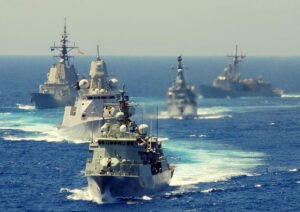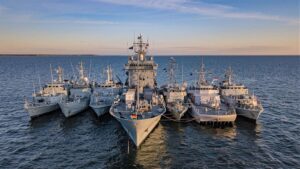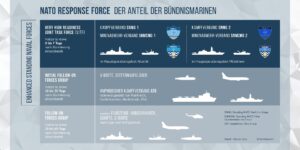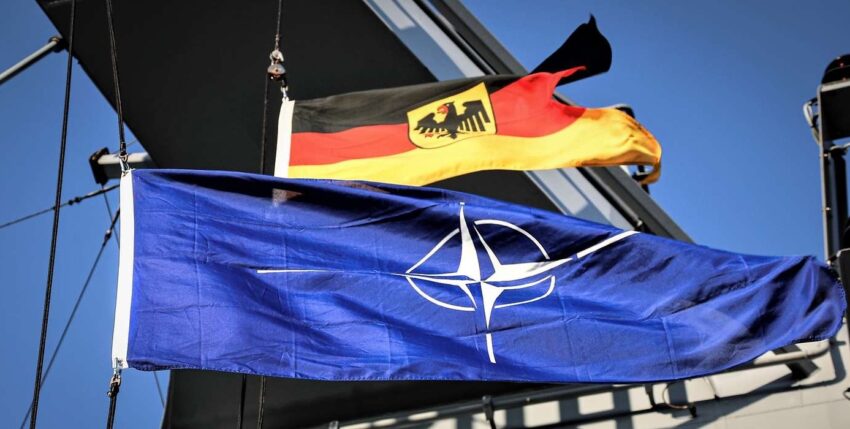[et_pb_section fb_built="1" admin_label="section" _builder_version="3.22" global_colors_info="{}"][et_pb_row admin_label="row" _builder_version="3.25" background_size="initial" background_position="top_left" background_repeat="repeat" global_colors_info="{}"][et_pb_column type="4_4" _builder_version="3.25" custom_padding="|||" global_colors_info="{}" custom_padding__hover="|||"][et_pb_text admin_label="Text" _builder_version="4.14.5" background_size="initial" background_position="top_left" background_repeat="repeat" global_colors_info="{}"]
From the newsletter of the German Navy
With four permanently deployable naval units, NATO is prepared for crises and conflicts at sea. Germany is involved in all of them.
The permanent contribution of the German Navy
The navy continuously participates in NATO's four multinational naval units - the Standing Naval Forces. As an ally, Germany has pledged to provide them with ships and boats on a permanent basis, even in peacetime. They are:
- Standing NATO Maritime Group 1,
- Standing NATO Maritime Group 2,
- Standing NATO Mine Countermeasures Group 1 and
- Standing NATO Mine Countermeasures Group 2.
In the Bundeswehr, these deployments of units to the Alliance are called "recognised missions", formerly also known as "operational commitments". They do not require the approval of the Bundestag because Germany has been a member of NATO since 1955.
In practice, these missions are only partially similar to the missions mandated by the German parliament. One of the most striking similarities is that the participating soldiers are away from home for several months at a time. Probably the most important differences to the missions are that some of the NATO units have been in existence for decades and that they are only roughly assigned to a specific region.
The superordinate headquarters of these task forces, the Allied Maritime Command (MARCOM), lies in Northwood near London. In peacetime, direct command by commanders on four flagships rotates annually among the NATO partners, and the participating ships and boats also change regularly. In the event of a crisis or conflict, the units are subordinated to specialised naval units, known as Maritime Component Commands.

NATO's surface combatants
The two Standing NATO Maritime Groups, SNMG 1 and SNMG 2 for short, consist of several warships from almost all NATO member states. As a rule, these are frigates specialising in anti-submarine warfare and destroyers optimised for air defence. They are also always accompanied by a supply ship to maximise the time at sea. Germany always participates with one naval ship per unit. The most important tasks of both SNMGs include the control and protection of strategically important sea lines of defence.
In peacetime, the SNMG 1 mainly operates in the North Atlantic, North Sea and Baltic Sea, but can immediately deploy to other crisis areas if necessary. These Maritime Group is the oldest in NATO. The naval organisation was founded in 1967 as "Standing Naval Force Atlantic"; It was given its current name in 2005.
The SNMG 2 mainly operates in the Mediterranean, but can also be deployed flexibly in other sea areas. The organisation was founded in 1992 under the name "Standing Naval Force Mediterranean"; It was renamed SNMG 2 in 2005.

The NATO minehunters
The Standing NATO Mine Countermeasures Groups, abbreviated to SNMCMG 1 and SNMCMG 2, are normally made up of several mine defence boats and a command and supply ship from various NATO partners - always including one from Germany. The task of the units is to search for and neutralise sea mines. They also remove old munitions from past wars and conflicts.
The SNMCMG 1 operates off the coasts of Northern Europe, primarily in the English Channel, North Sea and Baltic Sea. However, it can also operate in other regions if required. This mine defence unit was founded in 1973 as the "Standing Naval Force Channel" In 2005, it was renamed to the current SNMCMG 1.
The SNMCMG 2's main area of operation is the Mediterranean, although this can also be adapted if necessary. This latest Maritime Group of NATO was activated in 1999. It received its current designation SNMCMG 2 in 2005.
The maritime share of the NATO Response Force
Above all, their spatial flexibility makes the Standing Naval Forces The four permanent naval units are ideal maritime reaction forces that are available to the Alliance relatively quickly in the event of crises or conflicts. The four permanent naval units are therefore part of the NATO Response Force (NRF) or more precisely to the Very High Readiness Joint Task Force (VJTF). As its name suggests, this multinational battle group has a very high level of operational readiness. Its naval components, the four NATO naval units, are therefore also permanently available.

Continuous training for high operational readiness
Like its partners, the German Navy only deploys ships and boats that are fully trained and equipped. In order to maintain this operational readiness at a high level, the Maritime Groups take part in various national and international manoeuvres of NATO allies.
This ongoing training is just as much a part of the units' tasks as military deterrence or, if necessary, embargo controls, search and rescue operations and humanitarian emergency and disaster relief. Last but not least, ships and their crews serve as ambassadors in blue: the units regularly visit various harbours in allied or friendly countries.
The naval forces of the NATO partners have been practising their close cooperation for decades - and so has Germany. In the joint formations, they divide up the various individual tasks among themselves that are necessary for the group of ships to be able to defend itself on the one hand and act actively in the wider area on the other.
This multinational maritime division of labour is standard in NATO. Only a few allies maintain such a large fleet that they can bring together all the specialisations and capabilities of different warships at the same time in a purely national unit.
Source: On Course - The Newsletter of the German Navy KW 09
[/et_pb_text][/et_pb_column][/et_pb_row][/et_pb_section]









